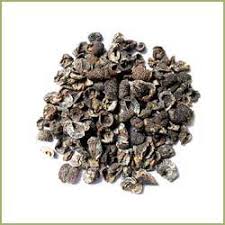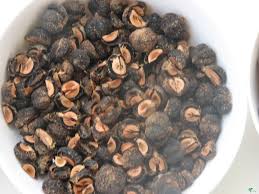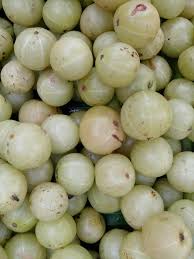Phyllanthus emblica-Amalaki
Embellica officionalis is a rich source of Vitamin C. It is a popular rasayana oushadha or a rejuvenative drug. In triphala choorna, chyavana prasa this one is a main ingredient.
Family : Euphorbiaceae ( Euphorbiaceae, spurge family of flowering plants, in the order Malphigiales, containing some 7,500 species in 275 genera. Many members are important food sources; others are useful for their waxes and oils and as a source of medicinal drugs; dangerous for their poisonous fruits, leaves, or sap; or attractive for their colorful bracts or unusual forms. Although species of the family grow throughout the world, except in cold alphine or arctic regions, most of them are found in temperate and tropical regions. The family consists of annual and perennial herbs and woody shrubs or trees, rerely climbers.
Flowers are of one sex, with male and female flowers usually borne on the same plant. Petals are rarely present. Flowers of Euphorbia are in cup-shaped clusters called cyathia, each of which seems to be a single flower, consisting of a single pistil surrounded by several male flowers, each of which has a single stamen. These clusters of reduced flowers are enclosed by an involucre(whorl) of bracts(modified leaves) that resembles a corolla, or whorl of flower petals.
Male flowers of the other genera have one to many stamens, free or joined. Female flowers have three-chambered ovaries that are superior( that is, above and not enclosed by other flower parts). There are as many styles as there are alternate ( or rarely opposite or whorled) in arrangement along the stems. The stems of many species contain a milky latex.
Members of the family known for beauty or usefulness include the largest genus, Euphorbia, commonly called spurge, with a wide range of succulent plants from lawn weeds to cactuslike plants; ornaments such as Codiaeum, sandboxtree (Hura), copperleaf (Acalypha), Phyllanthus, redbird cactus (Pedilanthus), Jatropha; and economically important plants such as castor oil plant(Ricinus communis), croton (Croton tiglium), Omphalea, cassava (Manihot esculenta), rubber (hevea), tung tree (Aleurites; a source of candlenut oil), and tallow tree (sapium). The manchineel tree (Hippomane mancinella) bears poisonous fruits, and mercury (Mercurialis) is a weed in many areas. )
Scientific name : Phyllanthus emblica
Phyllanthus, very large genus of flowering trees, shrubs and herbs of the spurge family (euphorbiaceae) that contains among its 650 species some of ornamental value and others with intresting botanical adaptations. Some have flattened, green stems, called phyllodes, that function as leaves. Whitish flowers cluster along the flattened stems of the west indian sea side laurel. There are similar reddish blooms on P.angustifolius. Other species have decidous twigs along which small leaves resembling leaflets alternate; the leaflets are shed along with the twig.
Species best showing this shedding adaptation are sometimes referred to two other genera, Cicca and Emblica, though many less-known Phyllanthus species have the same adaptation. Otaheite gooseberry is a small Indian tree bearing dangling clusters of light-yellow or green, vertically ribbed, acid-sour fruits, nearly 2cm in diameter; the fruit is used for making preserves. The long, deciduous twigs are lined with rows of sharp-pointed, alternating leaves.Because o fits even more feathery leaf bearing twigs, each with about 100 tinyalternating leaves, the emblic, or myrobalan, gives the impression of a hemlock. Its acid tasting yellow or reddish fruits are prescribed in traditional Indian medicine as a tonic. The leaves and bark contain tannin, utilized for tanning and as a colour concentrator in dyeing. The ddried fruit has been used as ink, hair dye, and detergent. The delicately branched Polynesian shrub, snowbush , is widely grown in the tropical gardens and as a greenhouse plant in the north for its gracefully slender branches and delicate green and white leaves.)
Names in other languages :
Sanskrit : Vayastha, Dhaatri, Dhaatriphala, Amrutha, Aamalaka, Vrushya, Shivam
Hindi : Amla
Bengali : Amlaki
Tamil : Nellikkai
Telugu : Nelli, Amlakamu
English : Indian Gooseberry
Distribution : Seen all throuhout India especially in marshy and leaf shedding forests.
Botanical description :
It is a leaf shedding tree of moderate height. Leaves are simple, sub sessile and closely set along branchlets.Leaves are 8-10mm long and 2-3mm broad. The colour of the leaves are greyish green. The same tree contains the male and female flowers. The flowers are greenish yellow. The number of female flowers are less than that of male flowers. The inflorescence are seen are small velvetty umbrellas. The sepals are 5-6, no petals.Contains 3 stamens. The ovary contains three chambers. Fruit is drupe. Fruit which is round and shiny consists of three parts.
Chemical composition :
The fruit contains pectins, vitamin C, B complex, calcium, iron etc inaddition to gallic acid, tannic acid, resin, sugars, carbohydrates, protein, albumin, cellulose.
Ayurvedic properties :
Rasa : Kashaya, Tikta, Madura, Amla
Guna : Guru, Ruksa
Virya : Sheeta
Vipaka : Madhura
Medicinal properties :
It alleiviates vata, pitta and kapha. When taken in large quantities it induces purgation. It is rejuvenative, nutritive and spermatogenic. It cures hyper acidity, blood impurities, blood vomitting, fever, diabetes, obesity, hair fall etc. It is cooling for the eye and improves vision. It improves intellect. It increases strength of the joints. It increases taste and digestive capacity.
Medicinal uses : Fruit, Roots, Bark.
Therapeutic usages :
-Bathing in warm water that has been processed with this berry regularly gives nutrition and freshness for the skin. It allieviates wrinkles and grey hairs.
-The juice of unripe berry when dropped into the eye cures almost all eye diseases
-The triphala powder prepared out of berry of emblic, chebulic and belleric myrobalans 3-6gm is beneficial in eye disorders, constipation and anaemia
-Juice of this berry, mixed with juice of tinospora cordifolia 10ml added with 1gm powder of turmeric regularly taken cures diabetes
-For ulcers of stomach 6gm berry mixed with 100ml of milk taken in morning regularly is beneficial
-For skin allergies 3-10gm gooseberry processed in ghee is beneficial
-During obstructed urination paste of gooseberry put over urinary bladder cures it
-For curing hyper acidity taking gooseberry powder along with ghee is beneficial
आमलकी नामानि गुणाश्च
वयस्यामलकी वृष्या जाती फ़ल रसं शिवं
धात्री फ़लम् श्रीफ़लम् च तताम्रुतफ़लम् स्मृतं
त्रिस्वमलकमाख्यातम् धात्री तृष्य फ़लाम्रुता
हरीतकी समं धात्री फ़लम् किन्तू विशेषत
रक्तपित्त प्रमेहग्नं परम् वृष्यं रसायनं
हन्तिवातं तदंलत्वात पित्तं माधुर्यशैत्यत
कफ़म् रूक्षकशायत्वात फ़लम् धात्र्या त्रिदोषजित
तस्य तस्यैव वीर्येण मजानमपि निर्दिशेत
त्रिफ़लानामानि गुणाश्च
पथ्याविभीत धात्रीणां फ़लैस्यात्त्रिफ़लासमै
फ़लत्रिकम् च सा वरा च प्रकीर्तिता
त्रिफ़ला कफ़पित्तघ्नि मेहकुष्ट हरा सरा
चक्षुष्या दीपनी रुच्या विषम ज्वर नाशिनि







Embellica officionalis is a rich source of Vitamin C. It is a popular rasayana oushadha or a rejuvenative drug. In triphala choorna, chyavana prasa this one is a main ingredient.
Family : Euphorbiaceae ( Euphorbiaceae, spurge family of flowering plants, in the order Malphigiales, containing some 7,500 species in 275 genera. Many members are important food sources; others are useful for their waxes and oils and as a source of medicinal drugs; dangerous for their poisonous fruits, leaves, or sap; or attractive for their colorful bracts or unusual forms. Although species of the family grow throughout the world, except in cold alphine or arctic regions, most of them are found in temperate and tropical regions. The family consists of annual and perennial herbs and woody shrubs or trees, rerely climbers.
Flowers are of one sex, with male and female flowers usually borne on the same plant. Petals are rarely present. Flowers of Euphorbia are in cup-shaped clusters called cyathia, each of which seems to be a single flower, consisting of a single pistil surrounded by several male flowers, each of which has a single stamen. These clusters of reduced flowers are enclosed by an involucre(whorl) of bracts(modified leaves) that resembles a corolla, or whorl of flower petals.
Male flowers of the other genera have one to many stamens, free or joined. Female flowers have three-chambered ovaries that are superior( that is, above and not enclosed by other flower parts). There are as many styles as there are alternate ( or rarely opposite or whorled) in arrangement along the stems. The stems of many species contain a milky latex.
Members of the family known for beauty or usefulness include the largest genus, Euphorbia, commonly called spurge, with a wide range of succulent plants from lawn weeds to cactuslike plants; ornaments such as Codiaeum, sandboxtree (Hura), copperleaf (Acalypha), Phyllanthus, redbird cactus (Pedilanthus), Jatropha; and economically important plants such as castor oil plant(Ricinus communis), croton (Croton tiglium), Omphalea, cassava (Manihot esculenta), rubber (hevea), tung tree (Aleurites; a source of candlenut oil), and tallow tree (sapium). The manchineel tree (Hippomane mancinella) bears poisonous fruits, and mercury (Mercurialis) is a weed in many areas. )
Scientific name : Phyllanthus emblica
Phyllanthus, very large genus of flowering trees, shrubs and herbs of the spurge family (euphorbiaceae) that contains among its 650 species some of ornamental value and others with intresting botanical adaptations. Some have flattened, green stems, called phyllodes, that function as leaves. Whitish flowers cluster along the flattened stems of the west indian sea side laurel. There are similar reddish blooms on P.angustifolius. Other species have decidous twigs along which small leaves resembling leaflets alternate; the leaflets are shed along with the twig.
Species best showing this shedding adaptation are sometimes referred to two other genera, Cicca and Emblica, though many less-known Phyllanthus species have the same adaptation. Otaheite gooseberry is a small Indian tree bearing dangling clusters of light-yellow or green, vertically ribbed, acid-sour fruits, nearly 2cm in diameter; the fruit is used for making preserves. The long, deciduous twigs are lined with rows of sharp-pointed, alternating leaves.Because o fits even more feathery leaf bearing twigs, each with about 100 tinyalternating leaves, the emblic, or myrobalan, gives the impression of a hemlock. Its acid tasting yellow or reddish fruits are prescribed in traditional Indian medicine as a tonic. The leaves and bark contain tannin, utilized for tanning and as a colour concentrator in dyeing. The ddried fruit has been used as ink, hair dye, and detergent. The delicately branched Polynesian shrub, snowbush , is widely grown in the tropical gardens and as a greenhouse plant in the north for its gracefully slender branches and delicate green and white leaves.)
Names in other languages :
Sanskrit : Vayastha, Dhaatri, Dhaatriphala, Amrutha, Aamalaka, Vrushya, Shivam
Hindi : Amla
Bengali : Amlaki
Tamil : Nellikkai
Telugu : Nelli, Amlakamu
English : Indian Gooseberry
Distribution : Seen all throuhout India especially in marshy and leaf shedding forests.
Botanical description :
It is a leaf shedding tree of moderate height. Leaves are simple, sub sessile and closely set along branchlets.Leaves are 8-10mm long and 2-3mm broad. The colour of the leaves are greyish green. The same tree contains the male and female flowers. The flowers are greenish yellow. The number of female flowers are less than that of male flowers. The inflorescence are seen are small velvetty umbrellas. The sepals are 5-6, no petals.Contains 3 stamens. The ovary contains three chambers. Fruit is drupe. Fruit which is round and shiny consists of three parts.
Chemical composition :
The fruit contains pectins, vitamin C, B complex, calcium, iron etc inaddition to gallic acid, tannic acid, resin, sugars, carbohydrates, protein, albumin, cellulose.
Ayurvedic properties :
Rasa : Kashaya, Tikta, Madura, Amla
Guna : Guru, Ruksa
Virya : Sheeta
Vipaka : Madhura
Medicinal properties :
It alleiviates vata, pitta and kapha. When taken in large quantities it induces purgation. It is rejuvenative, nutritive and spermatogenic. It cures hyper acidity, blood impurities, blood vomitting, fever, diabetes, obesity, hair fall etc. It is cooling for the eye and improves vision. It improves intellect. It increases strength of the joints. It increases taste and digestive capacity.
Medicinal uses : Fruit, Roots, Bark.
Therapeutic usages :
-Bathing in warm water that has been processed with this berry regularly gives nutrition and freshness for the skin. It allieviates wrinkles and grey hairs.
-The juice of unripe berry when dropped into the eye cures almost all eye diseases
-The triphala powder prepared out of berry of emblic, chebulic and belleric myrobalans 3-6gm is beneficial in eye disorders, constipation and anaemia
-Juice of this berry, mixed with juice of tinospora cordifolia 10ml added with 1gm powder of turmeric regularly taken cures diabetes
-For ulcers of stomach 6gm berry mixed with 100ml of milk taken in morning regularly is beneficial
-For skin allergies 3-10gm gooseberry processed in ghee is beneficial
-During obstructed urination paste of gooseberry put over urinary bladder cures it
-For curing hyper acidity taking gooseberry powder along with ghee is beneficial
आमलकी नामानि गुणाश्च
वयस्यामलकी वृष्या जाती फ़ल रसं शिवं
धात्री फ़लम् श्रीफ़लम् च तताम्रुतफ़लम् स्मृतं
त्रिस्वमलकमाख्यातम् धात्री तृष्य फ़लाम्रुता
हरीतकी समं धात्री फ़लम् किन्तू विशेषत
रक्तपित्त प्रमेहग्नं परम् वृष्यं रसायनं
हन्तिवातं तदंलत्वात पित्तं माधुर्यशैत्यत
कफ़म् रूक्षकशायत्वात फ़लम् धात्र्या त्रिदोषजित
तस्य तस्यैव वीर्येण मजानमपि निर्दिशेत
त्रिफ़लानामानि गुणाश्च
पथ्याविभीत धात्रीणां फ़लैस्यात्त्रिफ़लासमै
फ़लत्रिकम् च सा वरा च प्रकीर्तिता
त्रिफ़ला कफ़पित्तघ्नि मेहकुष्ट हरा सरा
चक्षुष्या दीपनी रुच्या विषम ज्वर नाशिनि